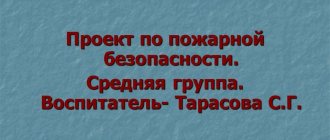Presentation to the teaching council “Safety of preschool children”
Description of the presentation by individual slides:
1 slide Slide description:
Pedagogical Council “Life Safety of Preschool Children” March 23, 2016
Slide 2 Slide description:
epigraph We must see, foresee, take into account. If possible, avoid everything, and where necessary, call for help.
Slide 3 Slide description:
Goal: to systematize teachers’ knowledge about the basics of life safety for preschool children. Objectives: 1. Theoretically substantiate the formation of life safety for preschool children. 2. Determine the content of the activities of preschool teachers to promote the life safety of preschool children. 3. Make a decision based on the results of the pedagogical council.
Slide 4 Slide description:
Preliminary work: 1. Development of Regulations for the competition “The best corner according to traffic rules” 2. Thematic control “State of educational work on the basics of life safety of preschool children” 3. Preparation of an information certificate on morbidity 4. Questioning parents, processing the results of the survey 5. Preparation of speeches 6. Creating a presentation 7. Inspecting corners according to traffic rules
Slide 5 Slide description:
Work plan of the pedagogical council 1. Relevance of the issue of life safety 2. Regulatory documents 3. Analysis of morbidity 4. Results of thematic control 5. Speech on the topic “Music therapy as one of the means influencing the mental health of a child” (music director Ledneva A.L. .) 6. Speech on the topic “Modern approaches to the concept of “children’s physical health” (Director of the Youth Sports School Veselova V.V.) 7. Training “Child Safety in Dangerous and Emergency Situations” (Deputy Head Nikanorova I.N.) 8. Summing up the review of corners on traffic rules 9. Draft decision of the pedagogical council
Slide 6 Slide description:
Relevance According to domestic and foreign researchers, human health depends 50–55% on one’s own lifestyle, 20–25% on the environment, 16–20% on heredity and 10–15% on the level of healthcare development in the country. You cannot improve your heredity and personally influence the level of health care, you cannot significantly change the environmental conditions of your existence, but the lifestyle that a person chooses depends entirely on him.
Slide 7 Slide description:
Statistical information 1. In the Ustyuzhensky district, there are a total of 3,145 minors. 2. Families in a socially dangerous situation - 22 (51 children in them) 3. In 2015, 95 reports were drawn up on parents of minor children 4. 1 report - on a 12-year-old child who was intoxicated 5. 11 crimes were committed minors (theft, hijacking, damage) 6. 30 crimes committed by the parents of minors (causing grievous bodily harm, committing theft, beating, committing an accident, cruel treatment...) 7. Administrative offenses - 47 (minor hooliganism, violation of traffic rules, causing minor damage to property, smoking in an unspecified place) 8. in 2015 in the Ustyuzhensky district, 1 minor child was injured as a result of an accident 9.
Slide 8 Slide description:
Concepts Human security is a state of a person when the action of external and internal factors does not lead to poor condition, deterioration in the functioning and development of the body, consciousness, psyche and the person as a whole and does not interfere with the achievement of certain goals that are desirable for a person. Security is ensuring safety from threats to life. and human health. Security - the state of protection of the vital interests of the individual, society, state from potentially and actually existing threats or the absence of such threats Life safety (LS) - the science of comfortable and injury-free interaction between a person and the environment
Slide 9 Slide description:
Currently, there are 79 definitions of “health.” Health is a normal function of the body at all levels of its organization. Health is the dynamic balance of the body and its functions with the environment. Health is the body’s ability to adapt to constantly changing conditions of existence in the environment, the ability to maintain the constancy of the body’s internal environment, ensuring normal and diverse life activities, and the preservation of the living principle in the body. Health is the absence of disease, painful conditions, painful changes. Health is the ability to fully perform basic social functions. Health is complete physical, spiritual, mental and social well-being. Harmonious development of physical and spiritual forces, the principle of the unity of the body, self-regulation and balanced interaction of all organs.
Slide 10 Slide description:
Analysis of incidence from 09/01/2015 – 03/23/2016 ARVI – 218 (129 + 90) Upper respiratory tract – 4 Gastrointestinal tract – 3 ENT – 8 Visual organs – 5 Skin diseases – 1 Children’s infections – 1 Other – 1 Urinary system – 0
Slide 11 Slide description:
Systems of personal and collective (public) security include the following main types of life safety: - health safety - psychological safety - anti-drug safety - anti-criminal safety - fire safety - technological safety - natural and environmental safety - transport security - information security
Slide 12 Slide description:
Survey results 1. Do you consider it necessary to familiarize children with safety rules at home? Yes - 40, no - 0 2. Who should prepare children for possible encounters with dangers? A). Parents - 38; B). Teachers - 29; IN). Medical workers - 11; 3. How do you teach children to handle dangerous objects at home: A). Hiding - 4; B). We prohibit - 12; IN). Learning to use - 34; 4.Is your child left alone at home for some time? If yes, what do you tell him when you leave: A). Don’t open the door for anyone - 24; B). Don't go to the phone - 7; IN). Don't play with matches - 15; G). Don't touch the medicine - 8; D). Do not turn on the gas, stove - 12; we don’t leave — 16 5. Does your child know his first and last name, home address, telephone number? A). Yes - 36; B). No - 1; IN). I don’t know - 1; 6. Do you think that a preschool child should be able to call help services by telephone? A). Ambulance (yes - 33, no - 6); B). Police (yes - 29, no - 10); IN). Firefighters (yes - 33, no - 6). 7. Do you need help from kindergarten teachers in becoming familiar with the rules of safe behavior at home? Yes - 30, No - 10
Slide 13 Slide description:
Training “Child Safety in Dangerous and Emergency Situations” So that the elements do not suddenly overtake us, so that trouble does not suddenly overtake us, we must take measures such that we are always ready to fight back! To win, look for a solution, You cannot retreat in the face of trouble, You will receive our knowledge And you will know how to apply it!
Slide 14 Slide description:
Task 1. “The fairy tale is a lie, but there is a hint in it.” Who can name more fairy tales where violation of the basics of life safety led to sad consequences. Explain why?
Slide 15 Slide description:
Task 2 1. The child received another vaccination. What type of acquired immunity did he acquire - natural or artificial? 2. Which organ of the human body is the largest? 3. What refers to postural disorders - scoliosis or flat feet? 4. An adult has 206 bones. Does the child have more or less? 5. Hammer, incus, stirrup - where is it located? 6. Why do you need a wisdom tooth? 7. What should be kept in your group's first aid kit?
Slide 16 Slide description:
Task 3 Children are told that a person’s appearance does not always correspond to his character. Children think that only people with an unpleasant appearance are dangerous, and that beautifully dressed and attractive people do not pose a danger. But this is not always true. What example from a fairy tale can you give?
Slide 17 Slide description:
Summing up the review of traffic rules corners
Slide 18 Slide description:
Decisions of the pedagogical council: 1. Teachers continue to work on establishing the foundations of safety with preschool children. 2. Create a working group to develop recommendations for working with parents on safety issues. 3. Teachers should develop a card index of literature for parents on life safety issues for preschool children. 4. In order to improve the professional competence of teachers, conduct a series of consultations, seminars, and trainings with the involvement of specialists from various services.
Brief description of the document:
general information
Leave your comment
Log in to ask questions.


